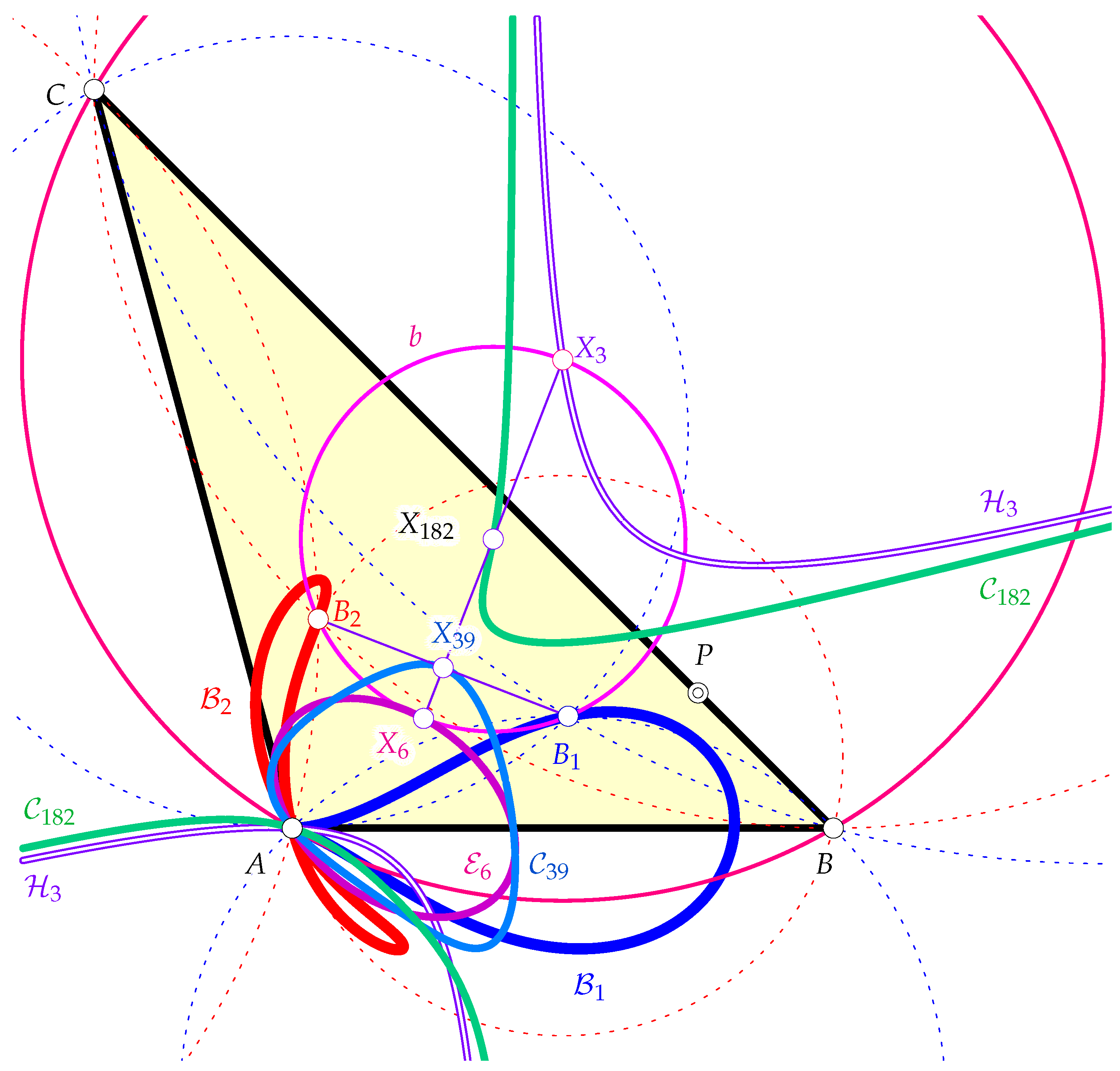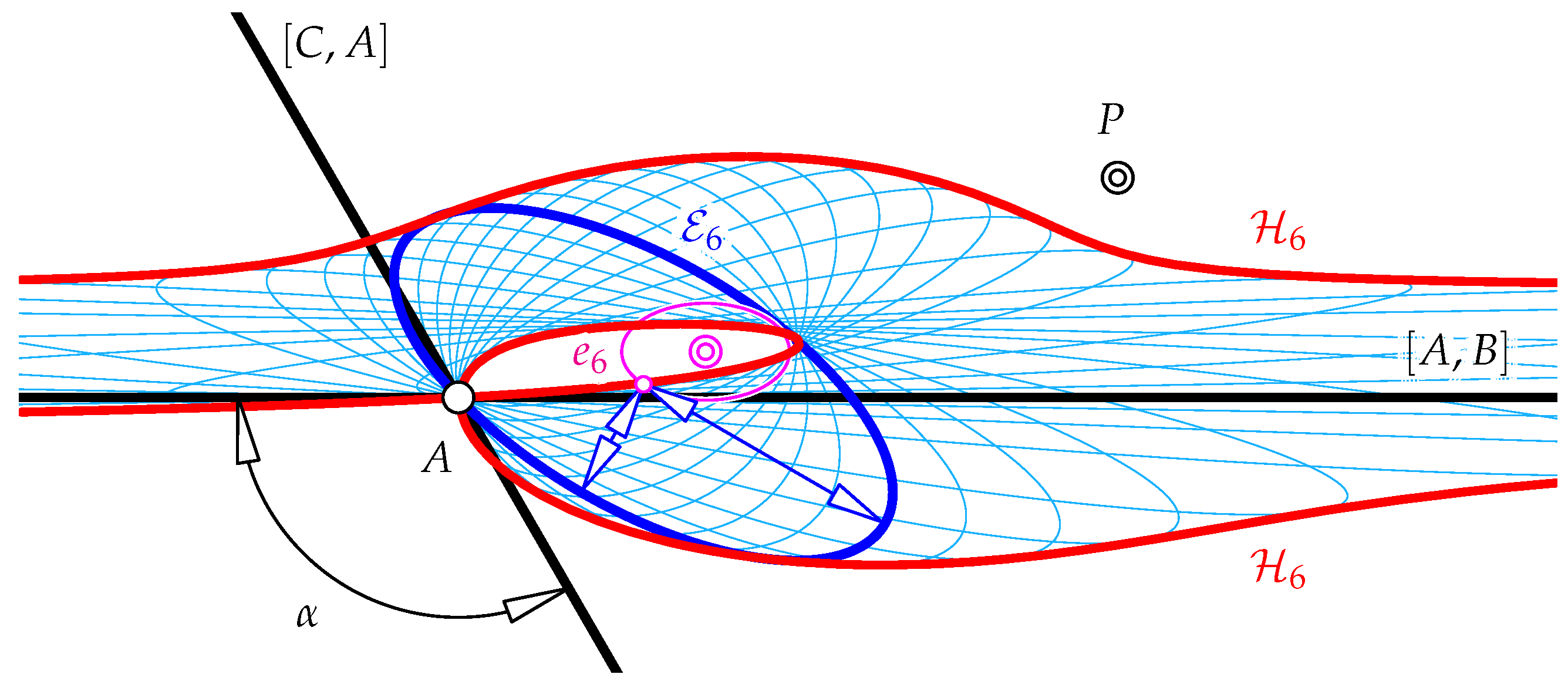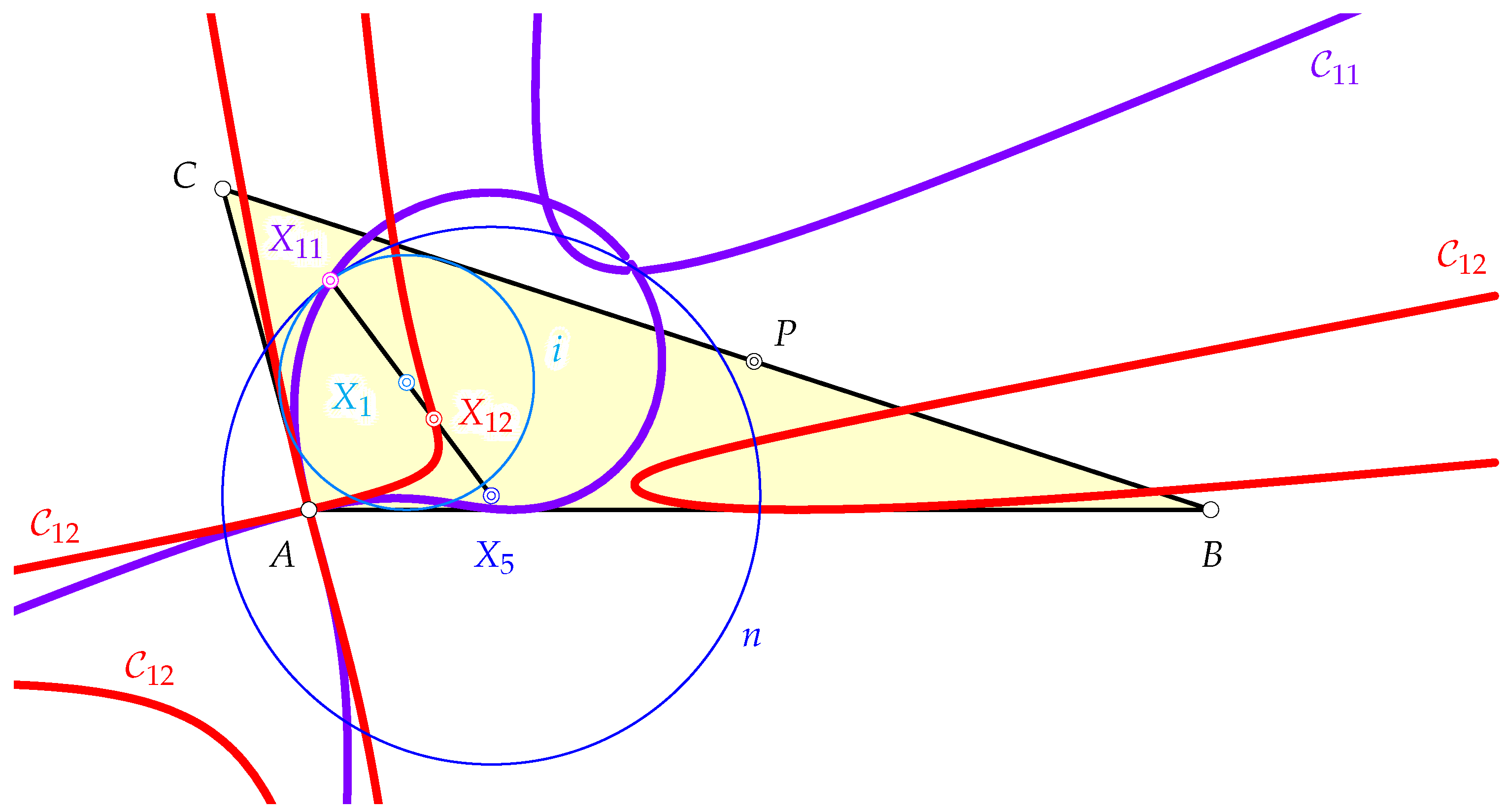2. Analytical Framework
We assume that the vertex
A of the triangle
coincides with the origin of a Cartesian coordinate system. The line
shall be the
x-axis of the frame and the line
(which encloses the angle
with the
x-axis) is given by the equation
as indicated in
Figure 1 (left).
The pencil of lines carrying the third side of shall be centered at with (i.e., ) and (i.e., ).
Now, we assume that is a coordinate in the pencil of lines about P and is a unit normal vector of the side line . Hence, an equation of is given by , where is the support function of .
The remaining vertices of the triangle
are then found as the intersection of
with
and
. So, the three vertices of
are parametrized by the following:
This describes a one-parameter family
of triangles. Allowing further
to trace
, we have parametrized a two-parameter family of triangles.
In principle, the parameter
is allowed to trace
freely. However,
results in an open triangle
(cf.
Figure 1, right), the vertex
is at infinity, and
is either anti-parallel to
(if
) or parallel to
(if
). If
, the line carrying
passes through
A and the corresponding two triangles
are point-shaped (see also
Figure 1). Finally, if
, we obtain the second pair of open triangles
(cf.
Figure 1).
All loci of points (and especially centers) related to the triangles in the family are traced twice, since agree as congruent triangles with differently oriented side line .
Now, the analytical representation (
1) allows us to formulate the following:
Theorem 1. The centroid , the circumcenter , and the orthocenter of Δ run on hyperbolae, while traverses the pencil about P.
Proof. A parametrization of the centroid
in terms of the underlying Cartesian coordinates is obtained as the arithmetic mean of the coordinate vectors (
1) of
’s vertices. This yields the following
which, after implicitization, i.e., after the elimination of the parameter
results in the implicit equation
The latter is the equation of a hyperbola with asymptotes
and
(since
), i.e., one is parallel to
, the other one is parallel to
, cf.
Figure 2.
The circumcenter
is the intersection of the bisectors of
’s sides. We obtain the parametrization
and further, by eliminating
, the implicit equation
It is rather elementary to verify that the latter is the equation of a hyperbola. The equations of its asmptotes are the linear factors of the quadratic form, see [
12]. This makes clear that
passes through the ideal points of the lines orthogonal to
and
.
is centered at
In order to complete the proof, we determine the orthocenter
of
and find the parametrization
that annihilates the following equation
Which clearly describes a hyperbola centered at
and passing through the ideal points of the normals to the fixed side lines of the triangles in the family. □
We shall also note that the centers (
4) of the hyperbola housing the circumcenters of the triangles in the family trace the parabola
if the triangles’ interior angle
traces
. The centers (
5) of the hyperbola generated by the orthocenters run on the parabola
The existence of a parabola as loci of centers of the hyperbolic orbits fit well with a much larger concept. So far, we have considered the orbits of three centers which are collinear, i.e., they lie on the Euler line. In this respect, we can show the following result:
Theorem 2. Any but two points X on the Euler line moves on a hyperbola while the moving triangle side traverses its pencil. The exceptional points move on the interior and exterior angle bisector through A and deliver the only degenerate conical loci of points on the Euler line. The centers of the hyperbola move on a parabola if the angle α at A traverses .
Proof. The parametrizations (
2) and (
3) of the orbits of
and
can be used to parametrize the range of points on the Euler line
and we have
We eliminate the parameter
in the pencil of lines about
P. For the sake of simplicity, we replace the trigonometric functions of
by their rational equivalents
Then, we find the quadratic equation of the orbits of the points
The latter is the equation of a hyperbola, since it shares the ideal points with the lines
The hyperbola degenerates if the following is met
and becomes either the repeated line
or the repeated line
. Since
, these repeated lines are the interior and exterior angle bisector of
at
A.
The centers of the hyperbola depending on the angle
can be described as
which clearly shows that for a fixed angle
(a family of triangles with a common angle at
A), the centers of the orbits of points
trace a straight line. However, we aim at the description of the locus of the orbits of the centers for varying
. For that purpose, we eliminate
(or
a) and obtain the equation
of parabola that touch the ideal line in the ideal point of
y-axis. □
3. Some Envelopes
3.1. The One-Parameter Family of Circumcircles
With (
3) we have already found an analytic representation of the circumcenters of the triangles in the family
. An equation of the one-parameter family of circumcircles of the triangles in
can be obtained, since the radius function equals
. The circumcircles of the triangles in the family
have the equation(s)
where
is the support function of the line
which still depends on
(a fact that should be taken into account when it comes to the computation of the envelope).
The envelope of the circles (
7) is now found by first differentiating
with respect to
and the subsequent elimination of
from both
and
. The elimination is simplified by replacing
and
by their rational equivalents. Besides some constant factors, the resultant of
and
contains the factors
which can be canceled, for they describe pairs of isotropic lines (of Euclidean Geometry, cf. [
12] p. 253). Any isotropic line splits off with multiplicity two from the envelope.
The essential part of the resultant yields the equation
We can summarize the results as follows:
Theorem 3. The envelope of the circumcircles of all triangles in the one-parameter triangle family is a rational and bicircular quartic curve with ordinary double points at the absolute points of Euclidean geometry and a cusp of the second kind at the point A. The tangent to the super-linear branch at A is given by the equationand encloses the angle with the line , where . Figure 3 shows the quartic curve
for a specific choice of
.
The computation of the nine-point circles as the circumcircles of the medial triangles of the totality of triangles in
is nearby. Their equations are
and the envelope
is computed in the same way as the envelope of the circumcircles. This results in the implicit equation
where the equations of the two pairs of repeated isotropic lines about
and
are cut out.
Summarizing, we can state:
Theorem 4. The envelope of the nine-point circles of the triangles in the family is a rational and bicircular quartic with an ordinary node at A.
If P is chosen on , then and the quartic becomes a repeated circle centered at and with radius .
Figure 4 shows the envelope
of the one-parameter family of nine-point circle for a specific choice of
.
3.2. Bicentric Pairs
We shall have a look at a special pair of bicentric points instead of browsing through a huge collection. The special pair shall be the pair of Brocard points.
The first Brocard point
is common to the three circles
,
, and
, where
touches
at
B and passes through
A (the other circles are obtained by cyclically replacing the ingredients). In order to determine the second Brocard point, we look for the meet of the circles
,
, and
, where
touches
at
A and passes through
B, and the other circles are constructed by cyclical shifts of points and tangents. We omit the lengthy representations of
and
and give the locus of the 1st Brocard points of the triangles in the pencil of triangles by the equation
The locus of the 2nd Brocard points of the triangles in the one-parameter family can be described by
We can summarize with the following:
Theorem 5. The 1st and 2nd Brocard points of the triangles in the family trace rational and bicircular quartic curves and with ordinary double points at A. one touches the line , touches the line at A.
Figure 5 shows the two bicircular quartics occurring as the loci of the two Brocard points of the triangles in the one-parameter family
of triangles inscribed in the angle at
A.
From [
10,
11], we know that the midpoint of the segment
is the center
, called the
Brocard midpoint. Further, the Brocard circle
b is now well-defined as the circumcircle of
’s circumcenter
and the two Brocard points. The center of
b is the triangle center
usually referred to as the
Midpoint of the Brocard Diameter (cf. [
10]). Finally, the Symmedian point
is the reflection of
in
.
Figure 6 shows the traces of the triangle centers
with
.
Hence, the orbits of the centers with can now be parametrized and the computation of implicit equations of their orbits is straight forward. Surprisingly, we find:
Theorem 6. The locus of all Symmedian points of the triangles in the one-parameter family is an ellipse .
Proof. The circumcenter
is already determined (cf. (
3)) and a parametrization of the orbits of the Brocard points
and
was computed prior to their implicit equations. Hence, the Brocard midpoint
which is the midpoint of
and
is well-defined. (An equation of the quartic curve parametrized by
can then be determined by eliminating the parameter
. We skip this, because it will not deliver essentially new insight.) The circumcenter of
and the two Brocard points
,
equals the center
, which traces a quartic curve passing through the ideal points of the normals to
and
. Now, the reflection of
in
results in the Symmedian point
where we have used the abbreviation
for the support function of
once again. The points
lie on the conic with the equation
which is an ellipse independent of the choice of
and for any admissible choice of
. □
The center of
equals the following:
If
is allowed to run through
, the latter is a parametrization of an ellipse
with the following equation:
centered at
with principal axes lengths
,
. The ellipses
pass through
independent of the choice of
and envelop an elliptic quartic
if
traces the unit circle.
Figure 7 shows some ellipses as orbits of the Symmedian point for triangle pencils with triangle sides
passing through
P and various choices of
.
We can collect the latter results:
Theorem 7. The ellipses as loci of the Symmedian point of all triangles with fixed α at A and side lines tracing the pencil about P envelop an elliptic quartic with a double point at A and at the ideal point of .
Proof. We only have to determine an equation of the envelope of all
given in (
9). This can be performed in the same way as in the case of the envelope of the circumcircles and we find
The ordinary double at A is obvious (no terms of degree lower than 2) and the double point at the ideal point of has the two tangents and . □
Figure 7 illustrates the contents of Theorem 7.
4. Traces of Some More Centers
There are some more triangle centers that can be reached with our analytical approach. The course of the incenter is rather unspectacular, since the pair of angle bisectors at
A is fixed once
is chosen. The incenter
allows for the analytical representation of the form
Similarly, we can give the coordinates of the excenters. Note that the incenter and the excenter that lies on the exterior angle bisector through
A interchange their roles as
is rotating around
P and forms the triangle “left” to
A. This phenomenon frequently occurs when triangles smoothly change their shapes and orientations (or turn from acute to obtuse), see for example [
1,
13].
The representation of the incenter given in (
10) leads to the vertices
(cyclic) of the intouch triangle
, written as follows:
Further, we shall give the coordinates of the excenter
opposite to
A
and skip the other two because of the complexity of their coordinate representation, and moreover, because
and
together with the vertices (
1) of
are sufficient in order to find the remaining excenters (if at all necessary).
4.1. Gergonne and Nagel Point
The perspector of
and its intouch triangle
is referred to as the Gergonne point
(cf. [
10,
11]). With (
11), we can find a parametrization of the curve of Gergonne points corresponding to the triangles in
. Then, we implicitize and find
The isotomic conjugate of
is the Nagel point
(cfs. [
10,
11]). In other words, the Nagel point is also the perspector of
and its extouch triangle
. This leads to a parametrization, and consequently, to the following implicit equation
Both curves
and
have an ordinary node at
A, since
A can be viewed as a “singular” triangle in
.
Figure 8 shows the curves
and
.
The quadratic factors in the inhomogeneous equations of and agree up to the constant factor . Thus, the two quartics also share the tangents at the common double point A.
4.2. Mittenpunkt
The Mittenpunkt
is the perspector of the medial triangle
and the excentral triangle
(see [
10,
11]). With (
1) and the excenters deduced from (
10), we find a parametrization of the trace of the Mittenpunkt, and further, the following equation
For a specific assumption on
, an example of the quartic curve housing all poses of the Mittenpunkt of the triangles in the family
is shown in
Figure 8.
For the very special choice of , i.e., P is chosen on the exterior angle bisector at A, the double point of at A becomes a tacnode with the tangent (orthogonal to passing through A).
4.3. De Longchamps Point, Bevan Point, Spieker Point
As a point on the Euler line, the de Longchamps point
travels on a hyperbola (according to Theorem 1) with the following equation:
which is centered at the following:
The equation of the hyperbola
can also be found by substituting
into (
6) and the corresponding implicit equation. The orbit of the centers of all
for varying angle
is the parabola with vertex
, axis parallel to the
y-axis, and the semi-latus rectum
.
We find the Spieker point
as the midpoint of the orthocenter
and the Bevan point
, cf. [
11]. Alternatively, but more intricate from the computational point of view, we could determine
as the incenter of the medial triangle
. According to [
11], the Bevan point is the midpoint of the Nagel point
and the de Longchamps point
. Hence,
and
. Since
(orthocenter of the anti-complementary triangle),
is the reflection of
in
, and consequently,
. Thus,
, which leads to a parametrization of the one-parameter family of Spieker points defined by the triangles in the triangle family
.
The implicitization of the parametrization of the Spieker point
shows that it traces the sextic curve
with the following equation:
up to constant coefficients.
If P is chosen on the exterior angle bisector at A, the ordinary node at A becomes a tacnode. The choice of causes split into a quartic curve and the repeated line .
The sextic equation of the orbit
of the Bevan point
starts with the following:
where constant factors are cut out. The double point at
A behaves in a way similar to that on
,
, and
depending on the choice of
P.
4.4. Feuerbach Point and Its -Harmonic Conjugate
The Feuerbach point
is the point of contact of the nine-point circle and the incircle
i of
. Since we have already found
, we also can give an equation of the incircle. Furthermore, the nine-point center
is the midpoint of
, the equation of the nine-point circle
n (as the circumcircle of the medial triangle) is then also nearby. The computation of the one and only common point of
i and
n yields a parametrization of the family of all nine-point centers and the subsequent elimination of the parameter
yields an equation of the nine-point orbit, written as follows:
which is a circular quartic curve. The curve
has three ordinary double points: at
A, and further, at the following:
The harmonic conjugate of
with respect to
and
is known as the center
. We shall not write down its implicit equation due to its length. However, the curve
is a rational quartic with an ordinary double point at
A and two further ordinary double points. The curves
and
for a particular choice of
can be seen in
Figure 9.














